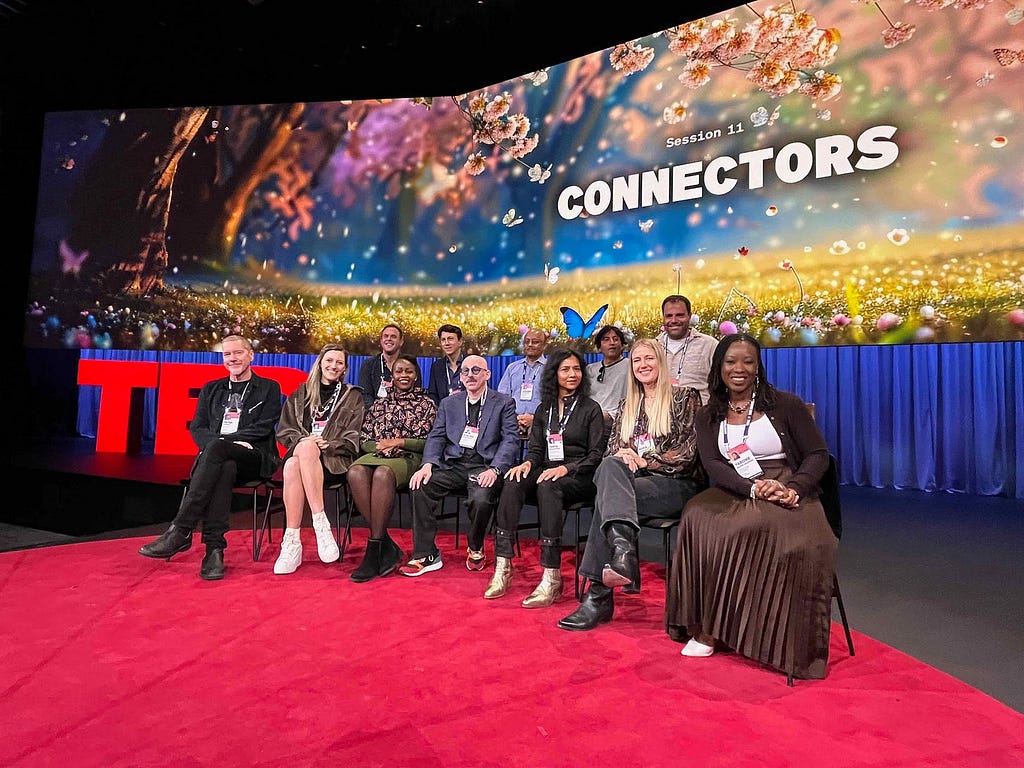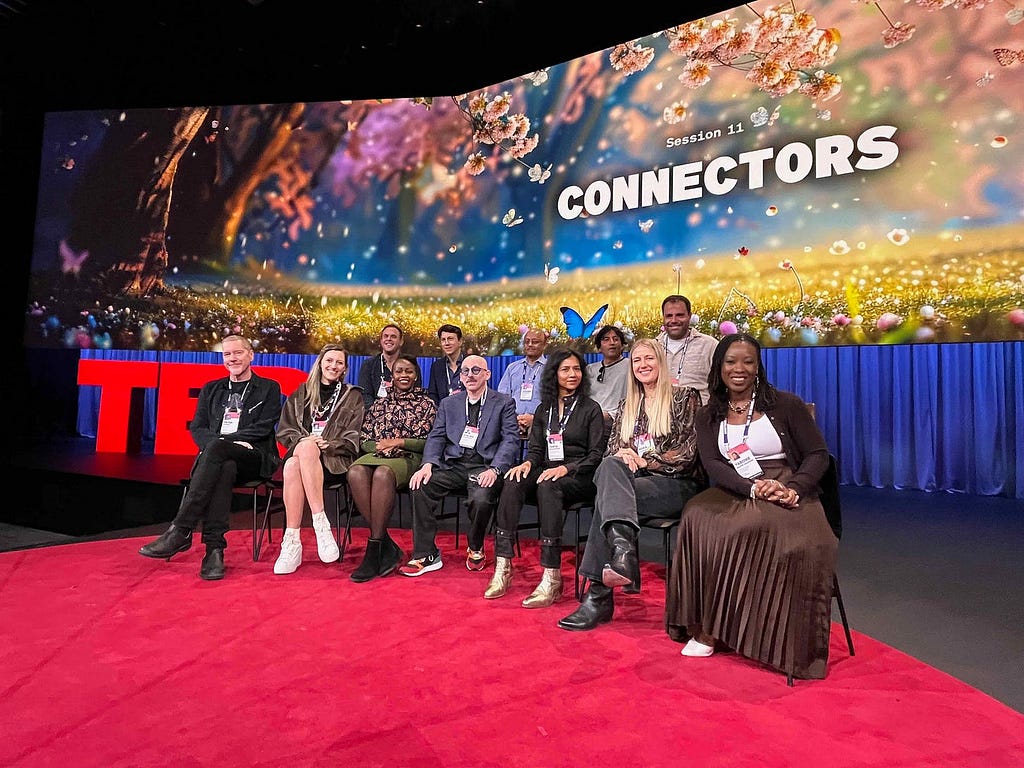TED2024 insights and reflections from a design leader (aka a creative-ish human)

In April, I was lucky enough to attend my third TED Talks conference, TED2024. This year, the conference theme was “The Brave and the Brilliant” and the talks ranged from how to build bridges between divided communities (more on that in the next post) to the power of art and education to the inevitable “Is AI good, terrifying, or something in between?”. As a design leader, I went into the conference with a desire to turn this question into more concrete takeaways for the tech and creative industries. The speakers and discourse with fellow attendees did not disappoint.
So will AI overtake human creativity or will the humans win out? Let’s find out.
The AI advantage: a low barrier to entry
Unlike a lot of new technologies (think about the early room-sized computers that required exclusive access to play with), AI has an incredibly low barrier to entry. Anyone with internet access can play with a form of generative AI today, often for free. In conversations with designers and other creatives, I often hear about this fear (one I’ve felt myself) that our jobs will be taken over by AI as a result of such rapid development and ease of access. There’s no denying that innovation can lead to redundancies. But there’s also no denying that innovation can also create a world of opportunities. So what can creatives do with innovation that has such a low barrier to entry?
Well, for one, artists can create more art. Niceaunties, an artist and designer based in Singapore, gave one of the most delightful talks at TED2024. She explained how AI removed constraints she had previously faced as an artist, things like budget, studio space, and client demands. AI also enabled her to pick up video editing as a skill that has expanded her art even further. Watch her talk for a visual roller coaster through the weird and wonderful world unlocked through AI and human creativity:
https://medium.com/media/ac1956f3eafa21a72679bc7870b7993b/href
With this low barrier to entry comes the relevant fears about licensing, the content that’s feeding algorithms, and the potential loss of work if “anyone can do it”. The main thing that captured my attention from Niceaunties’ talk was that this was an artist talking. She was in control of her creativity and the message she wanted her art to have. It’s one thing to churn out 1,000 images, it’s quite another to pull together the creative thought, tooling, and curation required to turn those images into art.
Another TED speaker with a take on how the low barrier to entry will help humans drive innovation was GitHub CEO Thomas Dohmke. Github’s Copilot* aims to make software development, a previously high-skilled and high-barrier-to-entry craft, accessible to anyone. Dohmke compared Copilot and other AI tools to everyone’s favorite toy, LEGO. I loved how Dohmke defined LEGO as a “system for realizing creativity with almost no barrier to entry”.
Similar to Niceaunties, Dohmke reminded us that a lower barrier to entry means more access and more inclusivity in industries that previously catered to a select few. Check out his talk here:
https://medium.com/media/33119023554f4eb67b861bd7249e7c74/href
*Github’s Copilot, not to be confused with Microsoft’s Copilot…perhaps AI could have helped provide a few more naming suggestions 😉.
The human advantage: systems thinking and taste
As Dohmke explained his desire to see everyone in the world coding, he also made it clear that these innovations don’t mean that all software developers will be out of a job. In fact, he was excited about the expanded roles and skillsets that AI tooling would open up. This sentiment was echoed by Scott Belsky, Adobe’s Exec VP of Design, during a discovery session (TED speak for a breakout session off the main stage) hosted by design legend debbie millman.

The discovery sessions aren’t as widely distributed as the main stage talk recordings so let me give you a quick recap. Millman spoke firsthand about her experiences designing through the technological advances of the ’80s and ’90s, when entire companies folded as computers and digital design took over. She challenged honor harger, Exec Director of Singapore’s ArtScience Museum, and Belsky to define what will actually help artists, designers, and other creatives really future-proof their careers in a world consumed by AI. Their main answers? Honing our skills in systems thinking and refining our taste (or eye for design).
It’s wonderful to have the tools, to do more with less, but that doesn’t replace the act of making and creating.
– Scott Belsky
In its most basic sense, systems thinking is about seeing beyond a single part (e.g., a review mirror) and considering the entire system (e.g., a car). Systems thinking has been around for a long time and is a foundational part of our work as designers. While the push to focus on systems thinking as AI intrudes into part of our jobs sounds compelling, I definitely left this conversation wanting to know more. How are we defining systems thinking in the design industry? What expectations are we setting as leaders looking to grow this skillset on our teams amidst other skills competing for our attention? As with any new innovation, there are usually more questions than answers and such is the case here.
In addition to systems thinking, the other advantage that humans will hold over AI is our ability to refine our tastes. Will AI eventually be able to feed off an algorithm that defines what quality design or compelling art looks like? Perhaps. But remember that it’s humans who build these algorithms and, therefore, define the parameters of taste.
Taste is what enables designers to navigate the vast sea of possibilities that technology and global connectivity afford, and to then select and combine these elements in ways that, ideally, result in interesting, unique work.
– Elizabeth Goodspeed
Both Harger and Belsky discussed how the role of taste will increase in importance as AI becomes a greater part of the creative process. Again, there are a lot of questions to be answered here about how we define taste, how we set guardrails for analyzing AI vs. human creations, and what the role of curators and design leaders will be in facilitating these conversations.
The AI and human disadvantages: accountability
Now if this were a conversation rather than a newsletter post, I could hear your “but what about?” questions bubbling up from a mile away. What about the answers to all of these questions? What about the creatives whose work is being repurposed without their consent? What about the lack of risks associated with such a low barrier to entry (from creatives losing their “seat at the table” to lower-quality output)?
Rumman Chowdhury, Data Scientist and AI ethics specialist, was one of a few TED speakers to call out the higher-level challenges and risks related to these questions. Chowdhury’s work includes poking holes in AI algorithms. She led the “red team challenge” at DEF CON 2023 (that name still sounds like a James Bond villain organization to me) in order to showcase how AI could be misused. These tests revealed that AI systems and the people who build them are both failing to be fully accountable for the lack of security and safety measures (like creative licensing).

(Chowdhury’s talk hasn’t yet been released but I’ll update this post with the link when it is.)
The good news is that more people are talking about these challenges. The bad news is that it feels uncertain how companies will be motivated to be accountable, aside from implementing a Responsible AI team that might or might not uphold the right standards.
Mustafa Suleyman, CEO of Microsoft AI (the org working on the other tool named Copilot), provided a helpful reminder on accountability. While Suleyman expressed optimism and excitement about the power of AI, he also likened AI to a digital species. Okay, so it’s maybe a little creepy to think about AI as an entire species, but the reason for this analogy was to get people thinking about the vast potential of AI, the associated risks with the new tech, and the need to impose boundaries. We have to remember our human agency here. Artists and creatives can push back. AI is not some alien power. Humans built it and humans can control it. You can watch Suleyman’s talk here:
https://medium.com/media/506b3bcd1abdee529d97f671be6c83a1/href
💡Where to from here?
One of the most important reminders that I took away from TED2024 is that people are inherently creative. A technological shift, no matter how rapid, doesn’t change our desire to be creative. Instead, it shifts how that creativity can take shape. There are still a lot of unknowns when it comes to AI and human creativity coexisting, so here’s what I recommend as some next steps to make this all feel a bit less ambiguous:
- Embrace the low barrier to entry by focusing on how you curate not just create outputs from AI. Mini case study: I worked with ChatGPT to help me generate over 20 different newsletter titles for this post in seconds (and, no, AI didn’t write the rest of this post). Saving time on title generation meant I could spend more time on title refinement, though you’re welcome to give me feedback on the curation choice 😉.
- Get a refresher on systems thinking and practice where you could apply this type of skill. Systems Thinking for Designers by Sheryl Cababa is one book I’ve just picked up. There is a lot more content out there on systems thinking and systems design, so leave your recommendations in the comments.
- Get a group of people together and talk about how you each define “taste”. This has long been a hot topic in the design and art world. Here’s a great article to help ground your conversation in this era of AI.
- If you’re working at a company building AI tools, ask about their responsible AI policy. If they don’t have one, you can join as a pay-what-you-want individual member of Responsible AI and learn about the path your company can follow.
On that note, I’ll leave you with one final question. What can you, as a designer or design leader, do to shape how AI and human creativity coexist?
Originally published in this newsletter. Thank you for reading!
Can AI coexist with human creativity? was originally published in UX Collective on Medium, where people are continuing the conversation by highlighting and responding to this story.

Leave a Reply